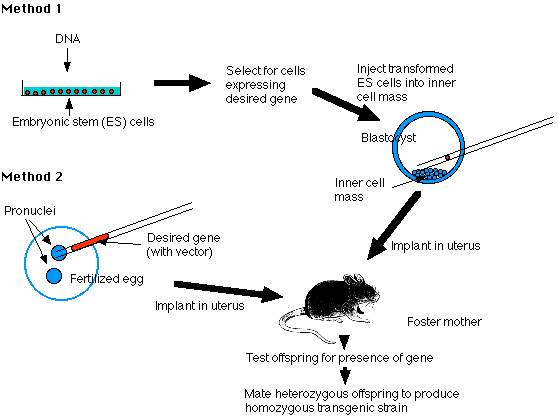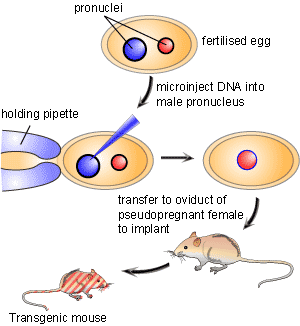Methods
There are three general methods for generating transgenic mammals. This includes DNA microinjection, retrovirus mediated gene transfer and embryonic stem-cell mediated transfer. Each of these techniques is used to study different aspects and serve specific purposes.
Retrovirus Mediated Gene Transfer Retrovirus transfer is gene transfer by means of a vector, virus, or plasmid. RNA encapsulated in a protein is entered into a cell, and retroviral* enzyme reverse transcriptase transforms the RNA into cDNA*, which the integrates itself into the genome. Retrovirus gene transfer can be used to study how the cell develops from an undifferentiated embryonic cell into a specialized cell. Retrovirus transfer can also be used to perform insertional mutagenesis* which is when a mutation occurs because of viral infection in an organism after the insertion of bases. These mutant organisms can then be examined for novel proteins or interesting properties. This method is not quite as easy, as it only works if the genetic material integrates into the germline, which does not always happen. Offspring produced from this method are usually chimeric*, meaning they contain two different sets of DNA, one contains the inserted transgene and the other does not. These chimeras must be inbred for up to 20 generations before homozygous transgenic offspring are produced. The retrovirus is beneficial in that it can be done at multiple stages during embryonic development and is much more flexible than microinjection. Embryonic Stem Cell Mediated Transfer Embryonic stem cell mediated transfer is different than the other two methods in that it can be done at the cellular level and does not require live offspring. This method uses embryonic stem cells, as the name suggests. These cells come from embryos and are usually grown in cultures. The reason these cells are so useful in transgenics is that they are pluripotent, meaning they can develop into most adult and fetal cell types. This method is used to study site-directed mutagenesis; in this process, the control elements of a gene can be mutated so that its function and development can be studied in greater detail. There are two methods to embryonic stem cell transfer. In Method 1, embryonic stem cells are extracted from the blastocyst, a structure made during embryonic development, which contains an inner mass of embryonic cells. The desired gene is then inserted into these cells and transformed in the culture, and the cells that express this gene are reinserted into the uterus of the organism and integrated into the germline. The second method uses a vector* to insert the gene into the pronuclei, which is then implanted into the uterus. In this method, the offspring produced can be tested for the transgene. |  Fig.4. Process of Retrovirus and Embryonic Stem Cell Mediated Gene Transfer DNA Microinjection DNA microinjection is the most common method used to create transgene animals. The reason it is so widely used is because it has a high success rate, the DNA inserted often becomes expressed in the transgenic animal, and includes an easy protocol. Microinjection is usually used when scientists are trying to express new genes into an organism. The first step of this process is to expose fertilized eggs to transgene before cell differentiation* so that the gene will be present in the animal while it evolves. The egg and sperm must then be fertilized in vitro* before the pronuclei* fuse, and the pronucleus is microinjected with the recombinant* DNA that includes the transgene. After injection fertilized eggs are then placed into the oviducts of a foster mother, who is able to carry the eggs after mating with a vasectomized male. When the offspring are born, a tissue sample is extracted and screened for presence of the transgene.  Fig.5. DNA microinjection Video 3. This video shows the process of entering DNA into a pronucleus using microinjection |